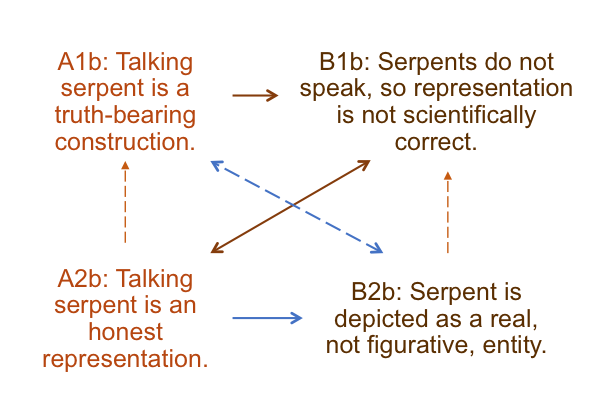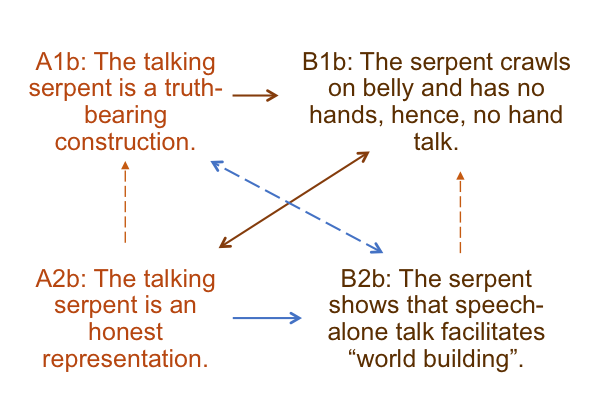0023 Kulikovsky’s section on biblical inerrancy opens questions of epistemology. Epistemology concerns Scripture and the problem of interpretation. Epistemology is the logos (word) of episteme (knowledge).
I have already encountered two contrasts. The first is truth versus falsehood, or correct versus incorrect. The second is truth versus deception, or honest versus deceptive.
0024 How does the talking serpent in Genesis 2:4-4 fit into this picture?
Science can prove that serpents do not speak, except, of course, for some of my old bosses and co-workers, if you catch my drift. This proof goes into B1b.
Also, the appearance of the talking serpent in the stories of Adam and Eve must be figurative, not real. But, the text depicts a real character. So, the talking serpent is a fiction… er… deception. This conjecture goes into B2b.

0025 What happens when I consider the hypothesis of the first singularity?
Well, the Genesis serpent ends up crawling on its belly. This means that it does not have hands or feet.
Also, the mythical talking serpent in Genesis misleads the naive Eve.
It does so using speech-alone talk.
0026 As it turns out, the hypothesis of the first singularity proposes that civilization is potentiated by a change in the way that humans talk, from hand-speech talk (two fully fledged ways of talking in a single language) to speech-alone talk (where hand-speech talk loses the hand component). The semiotic qualities of hand-speech and speech-alone talk are radically different. The change in semiotic qualities explains the potentiation of unconstrained social complexity.
Plus, the first culture to practice speech-alone talk is the Ubaid of southern Mesopotamia.
0027 Oh, suddenly, the story of the temptation of Eve makes more sense.
If the serpent has no hands, then it cannot practice hand-speech talk. Instead, the way the serpent talks makes it an exemplar of speech-alone talk (B1b).
This implies that the talking serpent is both figurative and real.
Plus, the talking serpent implies that speech-alone talk associates to the tree of the knowledge of good and evil. After all, that tree is the creature’s hangout.
0028 What else?
Presumably, hand-speech talk, which starts with the first anatomically modern humans over 200,000 years ago, associates to the tree of life.
0029 Yes, the semiotic differences between hand-speech talk and speech-alone talk are substantial. They are so great that the speech-alone talking serpent does not represent the traditions of hand-speech talk, characteristic of the Lebenswelt that we evolved in. Instead, the serpent draws Eve into the world that God commanded her not to enter, the world-building milieu of speech-alone talk.
Oh, speech-alone talk is the defining character of our current Lebenswelt.
0030 Here is a picture of the greimas square.

Consider the sequence of blogs for January 2022, at www.raziemah.com, titled, Looking at Mark Smith’s Book (2019) “The Genesis of Good and Evil”.
